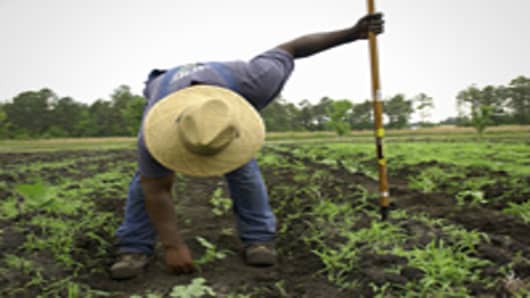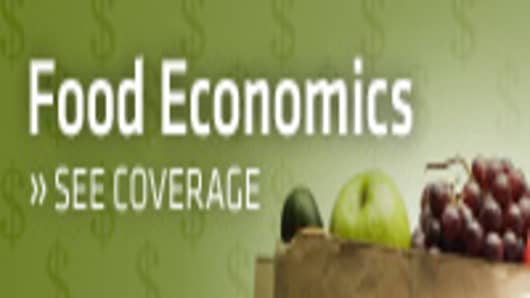Farm subsidies, including billions in direct payments that go to many farmers annually regardless of need, are on everyone’s federal budget chopping block this year.
Prices for most food commoditiesare at record highs, up 24 percent from February 2010 for all farm products tracked by the U.S. Department of Agriculture's National Agricultural Statistics Service.
And the healthy ag economy hasn’t escaped the attention of Congressional budget cutters looking at a projected 2012 deficit of $1.5 trillion.
“Commodity prices — farm products have never been higher — there's money there," said Senate Majority Leader Harry Reid (D-Nev.), who lists agricultural program cuts as “mandatory.”
House Budget Committee Chairman Paul Ryan (R-Wisc.) included $13 billion in cuts in farm programs in the budget plan that passed the House last week.
Before Ryan unveiled his plan, House Republicans already had planned to cut the USDA budget.
“The record-breaking prosperity of American farmers and farm communities is to be celebrated,” stated the House GOP budget plan. “But it also calls for re-examination of federal agricultural programs that spend billions each year, to ensure that taxpayers aren’t funding support for a sector that is more than capable of thriving on its own.”
The USDA’s budget authority for 2012 currently stands at $145 billion, up from $93 billion in 2008. Only $24 billion of the budget is discretionary. The rest funds mandatory programs such as the U.S. Forest Service, wildfire protection and crop insurance. Various nutritional assistance programs account for nearly 70 percent of the USDA budget.
President Barack Obama’s proposed budget lists $2.5 billion in cuts from farm subsidies by 2021. The Simpson-Bowles Debt Commission that Obama authorized last year made similar recommendations.
“The stars are aligned. This is the time to strike,” said Prof. Dana Hoag, who teaches agricultural economics at Colorado State University. “Because crop prices are high, no one will care as much.”
Federal spending in agriculture is set every five years when Congress passes the Farm Bill. The 2008 Farm Bill, crafted in a year that featured a $160-billion federal deficit, expires next year. Extensive Congressional hearings in the last half of this year will set priorities for the 2012 bill, and almost no one expects the $5 billion in annual direct payments for farmers to survive.
“I think direct payments are going to be done away with,” Sen. Chuck Grassley, R-Iowa, told reporters earlier this month. “The question is whether the $5 billion will be saved or will it go into other programs.”
Direct payments began in 2002 as a means of weaning farmers off production-based subsidies that had artificially inflated and deflated commodity markets over the years. Since direct payments are not linked to production, they support farm income without distorting farmers’ crop decisions.
Congress wanted to de-couple farm subsidies from production, Hoag said. “Whenever government interferes with the market, it makes it less efficient. You can’t manipulate prices without manipulating production.”
The payments started out as an informal type of crop insurance, Hoag said, ensuring a safety net during bad years. But there haven’t been many. Though the direct payments were meant to be transitional, they’ve perpetuated themselves over 10 years of unsuccessful efforts to scale them back.
Direct payments to farmers reached more than $24 billion in 2005, but had fallen to less than $5 billion last year.
Now direct payments have become an oft-used example of wasteful government spending, since farmers get the same amount of money each year, no matter how their crops fare.
“There’s the joke that asks how a farmer can double his income,” Hoag said. The answer? “Buy a second mailbox.”
Direct payments also are criticized because the money often goes to farmers who don’t exactly need it. Until 2008, farmers who had annual income up to $2.5 million qualified. Then the limit was re-set to $1.25 million. Obama’s 2012 budget proposal drops the eligibility limit to $500,000, with a maximum payment of $60,000 for a married couple, down $20,000.
Chief among those critics is the Environmental Working Group, a nonprofit based in Washington that tracks farm subsidies. EWG’s Don Carr, a senior policy adviser, says only 38 percent of farmers and ranchers receive any subsidies. Of those who do, nearly three quarters go to the top ten percent.
Hoag dismisses such criticism. “Helping small farmers has never been a goal of the Farm Bill,” he said. “Helping Americans with high quantities of high-quality, low-cost food is the goal. In a commodity program like this, the money is going to go to those who have the lowest cost, which is going to be the farms that have the highest quantity. If that is the goal, people shouldn’t care if it goes to rich people."
But this year, there’s a budget-cutting bulls-eye on the program that even traditional farm lobbying groups like the American Farm Bureau has noticed. Though the group officially maintained its support for direct payments at its convention in Atlanta this January, there was dissension.
Iowa Farmers Stand Out
The Iowa Farm Bureau, which represents the state that receives the second-largest amounts of subsidy, called for an end to direct payments and a move to more crop insurance, which would kick in only when times are bad.
TheColorado Farm Bureau seems similarly inclined. Spokesman Troy Bredenkamp told reporters, “To be honest, we get beat up over direct payments all the time. [They] have helped maintain an abundant and affordable food supply for the United States, but on the other end we’re tired of getting a black eye for it. There’s a better way to handle a safety net for agriculture than through direct payments.”
Even American Farm Bureau lobbyist Mary Kay Thatcher acknowledged her group sees the handwriting on the wall in the 2012 Farm Bill.
“I don’t think there’s anybody who doesn’t think we’re going to look at direct payments,” she said. “We need to look at what is really necessary in the safety net and what farmers and ranchers could live without.”
Vilsack, a former Democratic governor of Iowa, has been barnstorming through the Farm Belt, “trying to identify the fundamental principles that will drive the Farm Bill discussion,” he said.
His discussions have included “how to do more with less, and on whether to continue to provide farmers with a little bit of help every year, or more substantial assistance when it’s needed most.”
Hoag, who has served as an adviser on several Farm Bills, warned against characterizing the 2012 Farm Bill’s provisions before it’s signed.
“Never discount what happens at 11 hours and 59 minutes,” he said. “People make deals at the last minute.”



